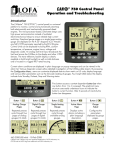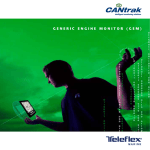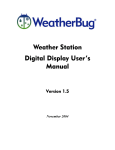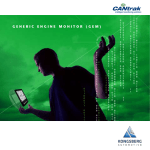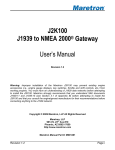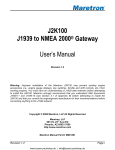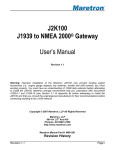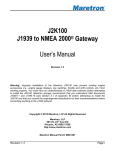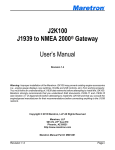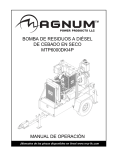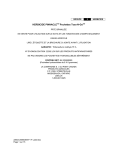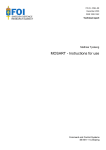Download ™ 600 Control Panel Operation and Troubleshooting
Transcript
™ ™ 600 Control Panel Operation and Troubleshooting Introduction The CANplus™600 (CP600™) control panel is an economical platform to monitor and control electronically governed diesel engines. Graphical gauge pages or a single large analog gauge are displayed on the 4.25” diagonal LCD. Virtually any SAE J1939 parameter reported by the ECU (Engine Control Unit) can be displayed including RPM, coolant temperature, oil pressure, engine hours, voltage and diagnostic codes. The trans-reflective, backlit display is clearly readable in both bright sunlight as well as total darkness and housed in a rugged IP67 rated housing. Current alarm conditions are displayed in plain language on popup messages and can be viewed in the alarm list. Various diagnostic screens allow detailed investigation of the CANbus data stream. By accessing the Configuration Menu, users can customize displayed data to show metric or US units, display language and various other parameters such as the full-scale reading of gauges. Five buttons access a context dependent button bar when any button from 1 to 4 is pressed. The graphical menu structure uses easily understood icons to indicate the button’s current function. After 5 seconds of inactivity the button bar disappears. Button 1 Button 2 Button 3 Analog Gauge Pages Digital Gauge Pages Single Analog Gauge Repeated presses cycle through four pages of analog gauges (16 total). Repeated presses cycle through four pages of digital gauges (16 total). Repeated presses cycle through various available analog gauges. 463-3000-07 Initial - 24-Jul-2007 CANplus, CP600, CANplus logo and LOFA logo are trademarks of LOFA Industries, Inc. Button 4 Button 5 Active Alarm Page Gauge Adjust Displays active alarms including a plain language description. Allows configuring the parameters used by gauge pages. 1 600 Control Panel Operation and Troubleshooting Note Most problems with electronically controlled engines can be pinpointed via ECU diagnostic messages. Use the display or ECU diagnostic tool to view fault codes. All engine state information and diagnostic codes displayed by the CANplus display are provided via the CANbus. Throttle Control The standard ramp throttle uses a momentary rocker switch to adjust the integral throttle control. All throttle commands are sent directly to the engine using CANbus throttle control. Note Throttle control requires CANbus throttling to be enabled in the ECU. CANbus throttling is also identified as Torque Speed Control and TSC1. Rotary potentiometers are available for ECUs that do not support CANbus throttle control. Other throttle options include digital rotary hand throttle, two-state throttle rocker switch (idle/run) or threestate throttle rocker switch (idle/intermediate/run). The three-state throttle rocker switch can be used in conjunction with the digital rotary hand throttle to adjust the intermediate speed. Service Timers The CP600 panel provides sixteen (16) service timers to alert the operator to needed maintenance. The time interval for each of the timers can be adjusted in 10 hour increments. A popup message is displayed after the display self test if a timer has expired alerting the user that service is required. The popup message continues to be displayed at power up until the timer is disabled or reset. Telemetry Option The optional telemetry system provides a variety of features to protect and support your equipment investment. Remote monitoring can alert maintenance requirements, operational problems, improper operation and theft. The Web-browser interface allows monitoring an entire fleet of equipment in a central location. LED Option Four optional bright LEDs indicate Power, Preheat, Stop and Warning status. These LEDs are controlled directly by the ECU. Warning When replacement parts are required, LOFA Industries recommends using replacement parts supplied by LOFA or parts with equivalent specifications. Failure to heed this warning could lead to premature failure, product damage, personal injury or death. 2 463-3000-07 Initial - 24-Jul-2007 600 Control Panel Operation and Troubleshooting Important Safety Information The warnings in this publication are not all inclusive. LOFA Industries cannot anticipate every potential hazard. Appropriate safety rules and precautions should be followed with any tool, work method or operating procedure. Improper procedures, tools and materials may cause damage or make the equipment unsafe to operate. Only persons with appropriate training, skills and tools should perform these functions. Improper operation, maintenance or repair of this product can be dangerous and may result in injury or death. Do not operate or perform any maintenance or repair on this product until all operation, maintenance and repair information is read and understood. The information, specifications and illustrations in this publication are based on information available at the time of publication. All items are subject to change at any time without notice. 463-3000-07 Initial - 24-Jul-2007 3 600 Control Panel Operation and Troubleshooting Operation Turning the control system key to the run position energizes the ECU and displays a start-up screen while the display performs a self test. If the display beeps for longer than 1 second, it indicates a self test fault. Users can attempt to rectify the fault by restoring factory defaults (see Configuration Menu for details). Contact LOFA Industries for assistance if the fault persists. After the start-up screen disappears, the display shows readings on its virtual gauges. Initially the analog gauges are displayed but the display uses the screen last displayed on subsequent startups (see Preferred Screen Store for details). If the ECU is preheating when the key switch is turned to the run position, the optional Preheat LED is illuminated. Preheat time varies with atmospheric and engine conditions. After waiting for the Preheat LED to extinguish, the engine is cranked by turning and holding the key switch in the start position until the engine starts. Note The ECU will not preheat unless conditions warrant. If necessary, starting the engine may be attempted by turning the key to the start position without waiting for preheat to expire. The key switch is spring loaded to return automatically to the run position when released. The key switch is equipped with a mechanical start locking device. An attempt to re-crank the engine can only be made by turning the key switch to the off position to reset the start locking mechanism. CANplus Display Soft buttons simplify the operator interface by displaying a button bar above the buttons when any of the first 4 buttons (buttons 1 to 4, starting from the left) are pressed. Icons on the button bar representing the current function of each button. The button bar disappears after 5 seconds if no further buttons are pressed. Note Different software versions may have slightly different displays. 4 463-3000-07 Initial - 24-Jul-2007 600 Control Panel Operation and Troubleshooting Analog Gauge Pages Analog Gauge Pages provide four independent pages of analog gauges. To enable Analog Gauge Pages, press any of the first 4 buttons to show the top level button bar and then press button 1 . Alternate pages are selected by repeated pressing of button 1. The four standard gauge pages are shown below. Note Engine Hours are displayed as a digital value even on Analog Gauge Pages. All 16 gauges may be configured by the user to create an application-specific view of CANbus data. Gauges are changed via Adjust Mode, accessed by pressing button 5 when the button bar is visible. In the adjust mode a new button bar is displayed identifying the new button functions. Button 1 the upper left gauge, button 2 gauge, button 3 corresponds to to the upper right to the bottom left gauge and button 4 to the bottom right gauge. Successive presses of any of the buttons selects a different parameter to display for the corresponding gauge. Adjust Mode is exited by pressing button 5 and configuration is stored even when power is removed. Note Gauge selections are limited to the data currently being received. Gauge pages can be configured in Demo mode to select any supported parameter. See Data Parameters Monitored for a complete list of available parameters. Adjust Mode can be disabled once gauge pages have been configured to prevent accidental changes (see Configuration Menu). 463-3000-07 Initial - 24-Jul-2007 5 600 Control Panel Operation and Troubleshooting Digital Gauge Pages Digital Gauge Pages display the same data as the Analog Gauge Pages but in digital format. To enable Digital Gauge Pages, press any of the first 4 buttons to show the top level button bar and then press button 2 . Alternate pages are selected by repeated pressing of button 2. The four standard gauge pages are shown below. Note The 16 gauges are the same for Analog and Digital Gauge Pages. Changes in either Analog Gauge Pages or Digital Gauge Pages affect the same gauge in the other mode. Single Analog Gauge Single Analog Gauge uses the entire display for a single large analog gauge. This mode is enabled by pressing any of the first 4 buttons to show the top level button bar and then press button 3 . The gauge displayed is selectable by repeatedly pressing button 3 while in the Single Analog Gauge mode while the menu bar is visible. 6 463-3000-07 Initial - 24-Jul-2007 600 Control Panel Operation and Troubleshooting Active Alarms A flashing popup window is overlaid on the current screen when an active alarm is received. The popup includes a plain language description in addition to the standard SPN-FMI pair defined by the SAE J1939 standard. Additionally the beeper sounds as an audible cue. Example alarm message, plus alarm list screens showing unacknowledged conditions and acknowledged alarms. After acknowledgement, the exit button becomes active. Note Standard J1939 abbreviations are used for alarms. MS = Most Severe, MOD= Moderately Severe, LS = Least Severe. Alarm List The Alarm List is accessed by pressing any button while an alarm popup is displayed or by pressing any of the first 4 buttons to show the button bar and then button 4 . Alarms not yet acknowledged are shown in grey on black while acknowledged alarms are shown in black on grey. The list also indicates when the alarm occurred if engine hours are available. The most recent alarm is displayed at the top of the list. The list can be scrolled using buttons 1 and 2 and alarms acknowledged by pressing button 3 . The Alarm List can be closed by pressing Button 5 once the alarms are acknowledged. An alarm indicator is displayed near the upper right corner of the display as long as alarms are active. The indicator and alarm messages in the list are automatically removed when the alarm is no longer received for a few seconds. 463-3000-07 Initial - 24-Jul-2007 7 600 Control Panel Operation and Troubleshooting Configuration Menu This Configuration Menu allows the user to set various operating parameters such as US or metric units, scale limits for tachometer and service timers. The configuration menu is entered by pressing and holding button 5 (the right hand button) in any mode for at least 3 seconds. If PIN entry is enabled the correct PIN must be entered to access the configuration menu. The top level configuration menu is displayed as shown. Buttons 1 and 2 allow you to choose from Display, System, Throttling, Telemetry or Db Viewer. Pressing button 4 selects the chosen menu item indicated in bold and the arrow . Each item is described in detail on the following pages. Settings are automatically stored when exiting the current menu even when power is removed. The top level Configuration menu and its five choices. Pressing Button 4 Button 5 selects the highlighted menu item. exits the configuration mode. Note Most configuration changes take affect immediately. Some such as Idle RPM take affect on the next power up. 8 463-3000-07 Initial - 24-Jul-2007 600 Control Panel Operation and Troubleshooting Display Menu The Display Menu allows the user to configure items affecting how information is displayed. Units Menu This menu allows the user to set the units used for speed, distance, pressure, volume and temperature independently. Button 4 changes the selected value. Speed MPH (miles per hour) km/h (kilometers per hour) Knts (knots) Distance Miles km (kilometers) NM (nautical miles) Pressure PSI (pounds per square inch) bar (barometric units) kPa (kilopascals) Volume Gal (US gallons) IGal (Imperial gallons) Liters Language Menu This menu allows the user to choose between English, Swedish, French, German, Spanish, Italian, Dutch and Portuguese. The currently selected value is indicated by the check mark Button 4 . selects the highlighted value. Bleep The soft buttons emit an audible beep when this item is On. Button beep is disabled by setting this item to Off. The audible beep still sounds when an alarm occurs. Temperature °F (Fahrenheit) °C (Celsius). 463-3000-07 Initial - 24-Jul-2007 9 600 Control Panel Operation and Troubleshooting Gauges Menu This menu allows the user to configure aspects of the gauges displayed on the display. Button 3 selects the previous value while Button 4 selects the next value of the highlighted item. Service Sets the sixteen (16) service intervals in hours and resets the service timer. Setting the service interval to 0 disables the timer and the word Off is displayed. Pressing Button 4 allows adjusting the selected service timer. Max RPM Sets the maximum RPM indicated by the tachometer gauge. RPM 2500, 3000, 3500, 4000, 4500, 5000, 6000, 7000, 8000 or 9000 Max Speed Sets the maximum speed indicated by the speedometer gauge. MPH 15, 20, 25, 30, 35, 40, 45, 50, 55, 60, 70, 75, 80, 85, 95 or 100 km/h 20, 30, 40, 50, 60, 70, 80, 90, 100, 110, 120, 130, 140, 150 or 160 Quad Adjust Allows the user to disable Adjust Mode of the Button 1 decreases the service interval time while Button 2 increases the service interval time in 10 hour increments. Holding Button 3 for approximately 3 seconds resets Next Service In to the current service interval. Note It is not possible to reset the service timer if engine hours are not being received by the display. Analog and Digital Gauge Pages. Button 3 disables while Button 4 Adjust. 10 enables Quad 463-3000-07 Initial - 24-Jul-2007 600 Control Panel Operation and Troubleshooting System Menu The System Menu allows the user to configure items affecting how the system functions. Demo The display supports several demo modes to operate with simulated data. Mode 1 simulates speed data and engine parameters. Mode 2 only simulates engine parameters. Mode 3 simulates speed data, engine parameters and alarms. Mode 0 disables Demo Mode. Demo is automatically set to 0 (Off) if live data is received. Restore Defaults This allows resetting all configuration information to default US or Metric units. Additionally the display is reset to the initial configuration. 463-3000-07 Initial - 24-Jul-2007 The default settings are: Setting US Metric Language English Button Beep On Service Timers Off Display Mode Analog Gauges Gauge Pages Defaults Quad Adjust On Demo Mode 0 (Off) Source Address 0 Display CAN Address 40 Alarm Filter Glb SPN Version 1 Speed Source Auto PIN Entry Off PIN 1111 Max Gauge RPM 2500 Max Gauge Speed 40 MPH 60 KmH Speed Units MPH KmH Distance Units Miles Km Pressure Units PSI kPa Volume Units Gal L Temperature Units ºF ºC 11 600 Control Panel Operation and Troubleshooting Com Viewer Engine Config Displays last CANbus messages received and engine configuration transmitted by the ECU. This screen displays the engine configuration information received from the ECU. J1939 Viewer This screen provides a hexadecimal dump of the last messages received on the CANbus. This viewer displays the raw data. To see the decoded data use the Db Viewer. Button 1 Button 2 selects the next page of engine configuration while button 1 previous page. select the J1939 Settings This screen allows adjustments specific to the J1939 data link. freezes the display while button 2 shows CANbus data statistics screen. Engine Source Selects which source the display listens to for gauge data. Every device on a J1939 network has a unique address (in the range 0-254) to which the display can choose to listen. The display listens to a single data source; usually Engine 1 at address 0. Note Incorrectly configuring the Engine Source address will result in no data available for display. 12 463-3000-07 Initial - 24-Jul-2007 600 Control Panel Operation and Troubleshooting Display Address PIN Settings As mentioned previously, every device has a unique address and the display is no different. In single engine setups the default display address is 40 (SAE recommendation). By default PIN security is disabled. The user is prompted to enter a PIN every time the Configuration Menu is accessed after this feature is enabled. Warning Incorrectly configuring the Display Address can result in data collisions on the CANbus. Alarm Filter This setting specifies whether the display will display alarms from all sources (Glb or global) or only the source address specified in the Engine Source setting (Src or source). SPN Version Selects the default SPN (Suspect Parameter Number) conversion method version to 1, 2 or 3. Version 4 is automatically detected, but older engines will have to be set to 1, 2 or 3. PIN Entry This allows turning PIN Entry On or Off. To enable the PIN entry feature select PIN Settings and press button 4 to enable. The current pin must be entered (default is 1111) as a security feature. Once the PIN has been entered the feature is enabled. PIN Entry is disabled by setting PIN Entry to Off. Note Consult your engine supplier to establish the appropriate SPN conversion method version if alarm data is incorrect. Speed Source There are 3 sources of speed data the display can decode. The settings for this parameter are AUTO, NMEA, WHEEL, NAV and OFF. AUTO prioritizes the sources (highest to lowest); NMEA, WHEEL (PGN 65265), NAV (PGN 65272). The selection can be forced to one of the available sources by selecting it explicitly. Selecting OFF stops the display listening to any source of speed data. 463-3000-07 Initial - 24-Jul-2007 The digits of the PIN are entered by using the buttons corresponding to the digits of the PIN. Button 1 adjusts the first digit of the PIN. Button 2 adjusts the second digit, button 3 the third digit and button 4 digit. The PIN is entered using button 5 the fourth . 13 600 Control Panel Operation and Troubleshooting PIN Change This allows changing the PIN. The user is prompted for the current PIN About Displays the following product information: The user is prompted for the new PIN. The new PIN must be confirmed before the PIN is changed. ID/Build EEPROM PART No VERS CHK SOURCE LIB1 LIB2 If the new PINs match a confirmation screen is displayed. Serial number of the display Number of writes on EEPROM Unit part number Software version number Flash memory checksum The source of received data Low level system library version Low level Graphical Display Interface library version (if used) Note This screen can not be exited until the checksum calculation is complete. Checksum calculation takes approximately 10 seconds and is complete when the checksum value changes from “Calculating…” to a hexadecimal value such as “0x704E – OK” If the two PINs entered do not match an error message is displayed and the PIN is unchanged. 14 463-3000-07 Initial - 24-Jul-2007 600 Control Panel Operation and Troubleshooting Throttling Menu The throttling menu allows the user to configure throttle control. Idle RPM Intermediate RPM Selects the RPM the control system will request for idle speed. Idle can be set to compensate for parasitic loads such as hydraulic pumps or compressors. Selects the RPM the control system will request for intermediate speed. Note Intermediate RPM is only used with the optional three-state throttle switch. The minimum engine RPM is set by the ECU. Requesting a lower speed causes the engine to run at the ECU minimum RPM. Note Run RPM Selects the RPM the control system will request for run speed. Note Run RPM is only used with the optional two-state or three-state throttle switch. 463-3000-07 Initial - 24-Jul-2007 15 600 Control Panel Operation and Troubleshooting Telemetry Menu This menu allows configuring the optional telemetry system. Telem J1939 Address Defines address the telemetry module is using for CANbus communications. Status Displays telemetry and modem status information retrieved from the telemetry module: Note The display will be unable to communicate with the telemetry module if this address is incorrect. Modbus Address Selects the Modbus slave address the telemetry module will use for Modbus communications. 16 GSM Sig Strength Reg Stat Error Stat Alarm Ch Comm Stat Asset ID GSM ID 0 to 50, 99 if error GSM Registration Status Error status Alarm channel number Communication Status 31 character Asset ID 463-3000-07 Initial - 24-Jul-2007 600 Control Panel Operation and Troubleshooting Db Viewer The Database Viewer displays and decodes all data monitored by the display. This diagnostic tool allows viewing data not normally displayed. The list can be scrolled using buttons 1 and 2 and closed by pressing Button 5 . Note The Database Viewer is always in English regardless of language selected. Preferred Screen Store The display automatically stores the current screen as the preferred page after a delay of approximately 15 seconds. The display will use the last stored screen on the next power-up. Note Selecting Restore Defaults restores the Analog Gauge Pages and default gauges. Popup Messages and Alerts Service Required Users can set up to sixteen service timers in hours in the Configuration menu. The SERVICE REQUIRED popup is displayed at power up when one or more service timers has expired. Pressing any button removes the popup. If no button is pressed the popup closes in approximately 5 seconds. Pop-up warnings of service required and data communications failure. 463-3000-07 Initial - 24-Jul-2007 17 600 Control Panel Operation and Troubleshooting Data Communications Failure The data communications failure popup icon flashes if the display does not detect data. The warning disappears and normal operation resumes once data is detected. Note Incorrectly configuring the Engine Source address will result in no data available for display. Data Not Available Gauges and the Db Viewer will display normal when parameter data is received. if the desired data is not available. The display value returns to Adjusting Lighting and Contrast Pressing button 5 (the right-hand button) when there is no menu bar opens the lighting and contrast menu bar. The display has a number of back-lighting levels that allow the display to be read in the dark. The level is adjusted by pressing buttons 1 decrease or button 2 to increase Contrast is adjusted in the same manner using buttons 3 and 4 illumination. . Note The display adjusts the contrast with ambient temperature. Manual contrast adjustments are only necessary with extreme climate change. The menu is exited by pressing button 5 switched off. . The lighting and contrast settings are retained after the unit is Note If the contrast has been adjusted poorly, the factory setting is restored by pressing buttons 1 thru 4 simultaneously. This action does not change other user-configured settings. 18 463-3000-07 Initial - 24-Jul-2007 600 Control Panel Operation and Troubleshooting Optional Indicators Power LED (Green) A solidly illuminated Power LED indicates the keyswitch is in the on position. Preheat LED (Amber) A solidly illuminated Preheat LED indicates the engine is preheating. When the LED extinguishes, the preheat period is complete and the engine may be cranked. Note The CANplus display only reports when the ECU is requesting preheat. Cold starting aids may not be installed in all engine configurations. Engine Stop LED (Red) A solidly illuminated Engine Stop LED indicates the ECU has stopped the engine due to a fault. Note ECU programming determines the response to warnings and failures. Typically the ECU can be programmed to shutdown, derate or run to failure. The CANplus display only reports CANbus conditions. Warning LED (Amber) A solidly illuminated Warning LED indicates a warning reported on the CANbus. 463-3000-07 Initial - 24-Jul-2007 19 600 Control Panel Operation and Troubleshooting Typical J1939 Wiring Topology Most electronically governed engine installations include a harness with built in J1939 backbone. Use twisted shielded pair with a drain wire for CANbus wiring terminated with 120Ωresistors at each end. The maximum length for the bus is 131 feet (40 m) and stubs should not exceed 39 inches (1m) in length. 20 463-3000-07 Initial - 24-Jul-2007 600 Control Panel Operation and Troubleshooting Harness Sealed Connectors The provided Deutsch sealed weather-proof plug includes a locking ring device which must be turned counter clockwise to separate the connectors. To positively seat the connectors the locking ring is turned clockwise. Warning LOFA does not recommend using dielectric grease or sealant with sealed connectors. These chemicals may cause seal damage and allow water entry. Use LOFA provided cavity plugs to seal the connector if wires are removed. Unsealed Connectors For unsealed connectors exposed to the elements, LOFA recommends using dielectric grease to protect contacts. Warning LOFA does not recommend using sealant with unsealed connectors. Sealant traps moisture in the connector and encourages corrosion. Harness Routing The minimum routing radius of the wiring harnesses should be at least two times the diameter of the wiring harness. Bends should be avoided within 1 inch (25 mm) of any connector in order to avoid seal distortion allowing moisture to enter the connector. 463-3000-07 Initial - 24-Jul-2007 21 600 Control Panel Operation and Troubleshooting Battery Circuit Requirements Warning Improper wiring can cause electrical noise, unreliable operation and may damage the control system or other components. All power connections must be free from foreign materials, including paint, which may interfere with proper connection. A reliable dedicated power circuit must be provided for the control system. LOFA recommends the power connection be made directly to the battery. Grounding through frame members is not recommended! All circuit paths must be capable of carrying any likely fault currents without damage. Do not reverse the battery polarity. Attempting to crank the engine when the polarity of the battery connections is reversed may damage the control system. Battery Positive Connection The electronic control system operates on either a 12 VDC or 24 VDC electrical systems. The unswitched battery positive connection to the control system is made at the weather proof connector. The control system provides switched positive battery protected by solid-state MOSFETs. These outputs include integral protection against overloads and short circuits. An integral 40 AMP slow blow fuse protects the unswitched battery positive circuit. Powering the control system through dedicated circuits reduces the possibility of system damage. Warning Disconnecting the battery while the engine is running may damage electrical components. When using a battery disconnect switch, LOFA recommends using a 2 pole switch to disconnect both the battery and alternator output. Note A maximum of three ring terminals should be connected to a power stud in order to ensure integrity of the connection. The use of more than three terminals can cause the connection to become loose. Voltage Drop If control system voltage drops below 6 volts for more than one tenth of a second, the control system may reset causing the self test to reactivate. Resetting the control system is equivalent to quickly turning the key switch to off and back to run without starting the engine. Voltage drops can be caused by a discharged battery, transients from external equipment, improper wire sizes, faulty wiring or nearby lightning strikes. 22 463-3000-07 Initial - 24-Jul-2007 600 Control Panel Operation and Troubleshooting Suppression of Voltage Transients (Spikes) Warning The installation of voltage transient suppression at the transient source is required. LOFA follows SAE recommended electrical environment practices. Inductive devices such as relays, solenoids and motors generate voltage transients and noise in electrical circuits. Unsuppressed voltage transients can exceed SAE specifications and damage electronic controls. I Relays and solenoids with built-in voltage transient suppression diodes are recommended whenever possible. Refer to the illustration for proper installation of diodes when built-in voltage transient suppression is not available. Locate inductive devices as far as possible from the components of the electronic control system. When using electric motors it may also be necessary to add isolation relays to eliminate voltage transients, noise and prevent back feed. 463-3000-07 Initial - 24-Jul-2007 23 600 Control Panel Operation and Troubleshooting Welding on Equipment with Electronic Controls Proper welding procedures are required to avoid damage to electronic controls, sensors and associated components. The component should be removed for welding if possible. The following procedure must be followed if the component must be welded while installed on equipment with electronic controls. This procedure will minimize the risk of component damage. Warning Do not ground the welder to electrical components such as the control ground or sensors! Improper grounding can cause damage to electrical components! Clamp the ground cable from the welder to the component being welded. Place the clamp as close as possible to the weld to reduce the possibility of damage. 1. Stop the engine. Turn the key switch to the OFF position. 2. Disconnect the negative battery cable from the battery. 3. Open any installed battery disconnect switch. 4. Unplug the control system if possible. 5. Connect the welding ground cable as close as possible to the area to be welded. 6. Protect the wiring harness from welding debris and spatter. 7. Use standard welding methods to weld the materials. 24 463-3000-07 Initial - 24-Jul-2007 600 Control Panel Operation and Troubleshooting General Troubleshooting For additional information, refer to engine manufacturer troubleshooting guide. No response from starter motor Possible Cause No battery voltage to starter Battery discharged Tripped overcurrent protection No signal from control system Defective starter solenoid Defective starter motor Possible Remedy Verify wiring and battery connection (power and ground) Charge or replace battery, verify alternator charging Correct fault, replace or reset overcurrent protection No power to control system (see Control System Troubleshooting) Replace starter solenoid Replace starter motor Engine will crank but not start Possible Cause Engine not getting fuel ECU is not functioning Tripped overcurrent protection No preheat (cold condition) Possible Remedy Check fuel level, filter, fuel pump, verify no air in fuel lines See Engine Troubleshooting Correct fault, replace or reset overcurrent protection See Preheat Troubleshooting Engine runs and shuts down Possible Cause ECU shutdown Circuit overload protection tripped Voltage transients (spikes) Defective control system Possible Remedy Use display to view ECU diagnostic codes, use ECU diagnostic tool for more detailed information Correct overload, keep control system from overheating (over 167° F or 75° C) Add suppressor diodes, protect from nearby lightening strikes, shield induced spikes from other equipment, add electric motor control relay See Control System Troubleshooting Alternator not charging battery Possible Cause Broken or slipping alternator drive belt Alternator not excited Alternator output not connected Alternator not grounded Alternator faulty Possible Remedy Adjust or replace alternator drive belt Verify excitation circuit connected, replace faulty regulator Install charge wire Clean or add ground connection Replace faulty alternator 463-3000-07 Initial - 24-Jul-2007 25 600 Control Panel Operation and Troubleshooting Engine Troubleshooting Note Most problems with ECU controlled engines can be pinpointed via the ECU diagnostic messages. Use the display or ECU diagnostic tool to view fault codes. All engine state information and diagnostic codes shown by the CANplus display are provided by the CANbus. ECU programming determines the response to warnings and failures. Typically the ECU can be programmed to shutdown, derate or run to failure. ECU does not power-up Possible Cause No power to ECU Tripped overcurrent protection Faulty ECU Optional e-stop engaged Possible Remedy Locate reason for lack of power and correct (Circuit overloaded? Failed suppressor diode? Faulty wiring?) Correct fault, replace or reset overcurrent protection Replace ECU Disengage e-stop Engine not getting fuel Possible Cause Empty fuel tank Clogged filter Air in fuel lines Low fuel pressure Faulty fuel pump Possible Remedy Fuel engine Replace filter Bleed fuel lines Replace faulty fuel pump and/or clogged filter Replace fuel pump, correct wiring fault (electric fuel pump) Preheat Troubleshooting Engine is hard to start in cold conditions Possible Cause Start attempt before preheat complete Heater faulty Heater relay faulty Preheat control not functioning Faulty control system Possible Remedy Wait for preheat time to elapse, crank as soon as time elapses Replace heater Replace relay Correct wiring, correct ECU configuration Repair or replace ECU Engine produces excessive white smoke after starting Possible Cause Afterglow not enabled Heater faulty Heater relay faulty Preheat control not functioning Faulty control system 26 Possible Remedy Reconfigure ECU Replace heater Replace relay Correct wiring, correct ECU configuration Repair or replace ECU 463-3000-07 Initial - 24-Jul-2007 600 Control Panel Operation and Troubleshooting Control System Troubleshooting Control system does not perform self test Possible Cause Tripped overcurrent protection Faulty connection to battery Faulty control system Possible Remedy Correct fault, replace or reset overcurrent protection Correct battery connections (see Battery Circuit Requirements) Repair or replace control system Control system performs normal self test, engine cranks, runs and shuts down Possible Cause Engine Stop LED illuminated Possible Remedy Correct ECU stop condition, use ECU diagnostics Display does not display data Possible Cause Display lost power Engine Source address incorrect Display Address incorrect Display configuration problem CANbus failure ECU not sending data Possible Remedy Turn on key, verify display plugged into harness Change Engine Address in Configuration Change Display Address to 40 (default) Reset display using Restore Defaults Check CANbus (see Testing CANbus) Repair or replace ECU 463-3000-07 Initial - 24-Jul-2007 27 600 Control Panel Operation and Troubleshooting Testing a Warning or Shutdown Shutdown simulation with ECU controlled engines requires using the ECU diagnostic tool. Refer to the diagnostic tool documentation to simulate a warning or shutdown. Testing CANbus Most information provided to the CANplus display is sent by the ECU via the CANbus. CANbus is an international data bus used to support SAE J1939. If this connection is broken or improperly terminated, the CANplus display cannot show ECU parameters such as engine hours, oil pressure and diagnostic codes. This test procedure helps identify the problem location. 1. Disconnect the battery. Warning This test should be completed with the battery disconnected! Failure to disconnect the battery may cause ECU, panel or test equipment damage! 2. Identify the engine diagnostic plug. Connect an ohmmeter across the CANbus pins of the diagnostic plug. 3. A reading of 60Ωindicates both ends of the bus are terminated and the bus is intact. 4. A reading of 120Ωindicates only one end of the bus is terminated. Identify the CANbus terminator on the engine harness and remove it. a. An ohmmeter reading of 120Ωindicates the bus to the terminator in the panel is complete and the problem is between the panel and the engine terminator. b. An open circuit ohmmeter reading indicates the bus to the engine terminator is complete and the problem is between the panel and the diagnostic plug. 5. Reinstall the terminator resistor and reconnect the battery. a. If the ECU diagnostic tool is available, use it to verify the ECU is transmitting CANbus data. Refer to ECU documentation to identify and correct the error. b. If another panel is available for testing, replace the panel to determine if the error is in the panel. 28 463-3000-07 Initial - 24-Jul-2007 600 Control Panel Operation and Troubleshooting Diagnostic Trouble Codes (DTC) CANbus Diagnostic Trouble Codes are a pair of numbers; the Suspect Parameter Number (SPN) and Failure Mode Identifier (FMI). The SPN indicates the faulting subsystem and the FMI identifies the type of failure. Typical SPNs Standard SPN codes are defined by SAE J1939-71. Not all standard codes are provided by ECUs. Manufacturers may add additional SPN codes beyond the codes identified in J1939-71. Refer to ECU documentation for supported SPNs. SPN 51 91 94 98 100 110 111 Description Throttle Position Accelerator Pedal Position Fuel Delivery Pressure Engine Oil Level Engine Oil Pressure Engine Coolant Temperature Coolant Level FMI FMI codes are defined by SAE J1939-71. Refer to ECU documentation for correct interpretation of FMI codes for a specific SPN. FMI 0 1 2 3 4 5 6 7 8 9 10 11 12 13 14 15 16 17 18 19 20 thru 30 31 Description Data valid but above normal operational range Data valid but below normal operational range Data erratic, intermittent or incorrect Voltage above normal or shorted high Voltage below normal or shorted low Current below normal or open circuit Current above normal or grounded circuit Mechanical system not responding properly Abnormal frequency, pulse width or period Abnormal update rate Abnormal rate of change Failure mode not identifiable Bad intelligent device or component Out of calibration Special instructions Data valid but above normal operational range (least severe) Data valid but above normal operational range (moderately severe) Data valid but below normal operational range (least severe) Data valid but below normal operational range (moderately severe) Received network data in error Reserved for future assignment Not available or condition exists 463-3000-07 Initial - 24-Jul-2007 29 600 Control Panel Operation and Troubleshooting Data Parameters Monitored This table lists the engine and transmission parameters that are monitored via the CANbus. The parameters can be displayed by the user-configurable gauge pages or the single analog gauge. DB is an abbreviation for the internal database which stores all data transmitted from the engine/transmission. The complete database can be accessed on the display via the Configuration menu. Icon 30 Parameter Gauge Pages Single Analog Electrical (Volts or Amps) Electrical Potential Battery Potential Switched Net Battery Current Alternator Potential Alternator Current Fuel (L, Gal, lGal) or (L/h, Gal/h IGal/h) or (km/L, MPG or IMPG) Fuel Remaining Fuel Rate Instantaneous Fuel Economy Trip Fuel Economy Trip Fuel Trip Fuel Rate Total Fuel Used Fuel Leakage 1 Fuel Leakage 2 Distance (km, Miles or Nmiles) Distance Remaining Trip Distance Total Vehicle Distance Pressure (kPa, PSI or bar) Fuel Delivery Pressure Barometer Pressure Auxiliary Pressure 1 Boost Pressure Air Inlet Pressure Air Filter 1 Differential Pressure Injector Metering Rail 1 Pressure Injector Metering Rail 2 Pressure Coolant Pressure Engine Oil Pressure Transmission Oil Pressure Clutch Pressure Air Start Pressure Injection Control Pressure Temperature (ºC or ºF) Engine Coolant Temperature Engine Intercooler Temperature Engine Oil Temperature 1 Transmission Oil Temperature Turbo Oil Temperature Database 463-3000-07 Initial - 24-Jul-2007 600 Control Panel Operation and Troubleshooting Icon Parameter Gauge Pages Single Analog Fuel Temperature Intake Manifold 1 Temperature Air Inlet Temperature Exhaust Gas Temperature Auxiliary Temperature 1 Engine ECU Temperature Exhaust Gas Port 1 Temperature Exhaust Gas Port 2 Temperature Turbo 1 Compressor Inlet Temperature Percentage (%) Fuel Level Acceleration Position Throttle Position Engine Oil Level Coolant Level Estimated Percent Fan Speed Drivers Demand Percent Torque Actual Engine Percent Torque Torque Use at RPM Speed (RPM, km/h, MPH or KTS) Input Shaft Speed Output Shaft Speed Engine Speed Turbo 1 Speed Engine Desired Operating Speed Navigation Wheel Based Vehicle Speed Time (h) Total Engine Hours Trip Engine Hours Service Hours Miscellaneous Torque Converter Lock-Up Engaged Current Gear Selected Gear Database CANTX Disable Abbreviations The units MPG and Gal denote US gallons. For non-US US gallons (UK, Canada, etc) the units are denoted as IMPG or IGal. N denotes nautical miles. KTS denotes knots. Note If a parameter is not available it will not be possible to select it. If a parameter becomes unavailable while in view is displayed. 463-3000-07 Initial - 24-Jul-2007 31 600 Control Panel Operation and Troubleshooting Glossary CAN Controller Area Network (also referred to as CANbus); serial communications protocol for electronic engines use DTC Diagnostic Trouble Code; the combination of SPN and FMI that identifies a specific error ECU Engine Control Unit; electronic device responsible for controlling and monitoring engine operation FMI Failure Mode Identifier; defines the type of failure detected in the subsystem identified by the SPN GPS Global Positioning System; a system of satellites and receiving devices used to compute positions on the earth, used in navigation ISO International Standard Organization; an international organization working with the United Nations that maintains technology standards for global industry J1939 SAE engine data protocol using CAN 2.0B LCD Liquid Crystal Display; a display technology that uses electric current to align crystals in a special liquid. When current is applied the crystals change their orientation creating a darker area. NMEA National Marine Electronics Association, serial communications protocol for marine use RS-232 Standard electrical interface for serial communications RS-485 Standard differential electrical interface for serial communications SAE Society of Automotive Engineers; professional association of transportation industry engineers that sets most auto-industry standards for the testing, measuring, and designing of automobiles and their components Soft buttons Push buttons whose function changes according to use SPN Suspect Parameter Number; a number used to identify a particular element, component or parameter associated with an ECU Note The messages, icons and error codes displayed conform to J1939 standards wherever possible. A copy of the relevant standards documents may be accessed and purchased at: http://www.sae.org/standardsdev/groundvehicle/j1939a.htm 32 463-3000-07 Initial - 24-Jul-2007 600 Control Panel Operation and Troubleshooting Software Revision History 1.30 Initial release Document Revision Information Initial: 24-Jul-2007. 463-3000-07 Initial - 24-Jul-2007 33 600 Control Panel Operation and Troubleshooting Typical Schematic The following page shows a typical schematic. Details vary from installation to installation. See the specific schematics for installation for details. 34 463-3000-07 Revision - - 24-Jul-2007 600 Control Panel Operation and Troubleshooting P1 DSP1 J1 16 AWG Black Power VB- 1 1 Power VB+ 2 2 a RS232 TX+ 3 3 RS232 TX- 4 4 SP1 RS232 RX- 5 5 1 RS232 RX+ 6 6 CAN LO 7 7 CAN HI 8 8 RS485A 9 9 RS485B 10 10 Ext Alarm Op 11 11 l N/C 12 12 m 16 AWG Red B Battery (30) c D Starter (50) 14 AWG Black 2 SP2 18 AWG Lite Green 1 E Ground (31) f CAN Shield 16 AWG Red 2 18 AWG Yellow G Accesory (15) h 16 AWG Grey 16 AWG Red 16 AWG Lite Blue j Alternator Accy k n KS1 12 AWG Red/Black R1 J2 p 16 AWG Yellow 50 1 16 AWG Red 75 J3 83 J4 30 1 16 AWG Yellow 16 AWG Red r Throttle Select s Sensor Return t u CAN Low 12 AWG Red v CAN High 0I I 15 1 w x CTL1 J5 Vcc 1 1 RS485B 2 2 RS485A 3 3 Gnd 4 4 SW1 5 5 SW2 6 6 SW3 7 7 Gnd 8 8 16 AWG Black 16 AWG Yellow 16 AWG Yellow/Black 16 AWG Black RS1 1 1 C 1 2 1 J6 J7 J8 Part Number ©THE INFORMATION CONTAINED IN THIS DRAWING IS CONFIDENTIAL AND THE SOLE PROPERTY OF LOFA INDUSTRIES INC. Reproduction or dissemination in whole or in part in any form or medium without express prior written permission of LOFA INDUSTRIES INC is prohibited. All rights of design reserved 463-3000-07 Initial - 24-Jul-2007 INDUSTRIES, INC. Rev Description CP600 Generic Point to Point Date 7/24/2007 MANUFACTURER OF QUALITY ENGINE COMPONENTS www.LOFA.net 250 Hembree Park Dr Ste 122 Roswell GA 30076 Phone 770-569-9828 FAX 770-569-9829 Sheet of 35 463-3000-07 Initial - 24-Jul-2007




































